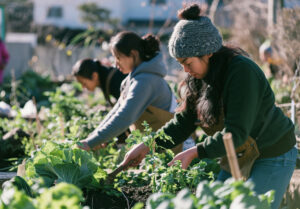Community Gardens Against Hunger and for Improved Child Nutrition
Faced with the need to ensure healthy food in children’s diets within local communities, various community projects are responding to the challenge. An overview of how these initiatives work.

In neighborhoods and communities where access to fresh, nutritious food is limited due to economic hardship, collective efforts are emerging to secure a daily meal. With the support of private donors and community contributions, immediate solutions are being implemented to meet this basic need.
Community Gardens: From Solidarity to Food Security
Independent of public policies or government programs, these community gardens have evolved into a model of alternative public health. They are natural spaces where local donations yield direct results through the harvest of fruits, vegetables, and greens—making nutritious produce accessible to families who cannot afford such foods in the marketplace.
Beyond improving the quality of food for both children and adults, these projects raise awareness about healthy eating, promote environmental education, and strengthen the social fabric of communities—critical factors for public health and well-being.
In Villa Esperanza, Buenos Aires, residents organized with a private foundation to turn an abandoned lot into a community garden aimed at providing fresh food.
Each week, volunteers harvest vegetables and fruits, distributing them among local families to supplement school meals and ensure that children receive a more diverse and balanced diet.
However, the impact of these gardens extends beyond food provision. A study by the Fundación Huertas Urbanas found that children who participate in gardening activities show greater knowledge of nutrition and are more open to trying foods they previously rejected—an important step in encouraging new, healthy eating habits.
This demonstrates that hands-on learning about nutrition and direct access to fresh produce can transform consumption patterns—one of the key ripple effects of this model.
Nutrition, Learning, and Social Impact
The nutritional benefits are clear. According to the World Health Organization (WHO), micronutrient deficiencies and the lack of fruits and vegetables in children’s diets contribute to physical and cognitive development problems.
Community gardens directly and sustainably address this issue by providing foods rich in essential vitamins and minerals. They also include healthy cooking workshops, where children learn to prepare nutritious dishes with available produce—adding an educational dimension to nutritional care.
Funding for these gardens largely comes from private donations, signaling a paradigm shift in approaches to public health. Local businesses, philanthropic foundations, and engaged citizens contribute financial resources, seeds, tools, and volunteer labor.
This model also reduces dependence on government action and enables faster, more adaptive responses to the specific needs of each community.
Participation in planting, tending, and harvesting crops fosters values such as cooperation, responsibility, and respect for the environment. Children and adolescents learn to value collective work, understand the origins of food, and recognize the importance of protecting natural resources.
In neighborhoods with limited access to green spaces, these gardens become safe, educational meeting places, also supporting the emotional and social development of young people.
Economic and Community Benefits
The economic impact of these projects is equally positive. By reducing the need to purchase fruits and vegetables, families can redirect resources toward other essential expenses such as education and healthcare.
At the same time, these gardens generate local employment opportunities, offering training in urban agriculture and jobs related to the logistics and distribution of harvested produce.
In this way, community gardens function as comprehensive structures that improve nutrition, promote education, and strengthen local economies.
In Rosario, a nonprofit organization supports school gardens involving student participation, complemented by workshops on hygiene and health care.
In Mendoza, a project backed by private donors distributes seeds and tools to vulnerable families, promoting the creation of household and community gardens that enhance children’s diets.
These initiatives show that philanthropy and private donations in urban and community agriculture are effective tools for improving child nutrition across diverse contexts.
Combining resources to build a sustainable food system within communities not only addresses basic needs but also reshapes the understanding of nutrition as a cornerstone of human development.


